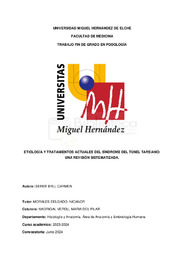Por favor, use este identificador para citar o enlazar este ítem:
https://hdl.handle.net/11000/33403Registro completo de metadatos
| Campo DC | Valor | Lengua/Idioma |
|---|---|---|
| dc.contributor.advisor | Morales Delgado, Nicanor | - |
| dc.contributor.advisor | Madrigal Verdú, María del Pilar | - |
| dc.contributor.author | Serer Bru, Carmen | - |
| dc.contributor.other | Departamentos de la UMH::Histología y Anatomía | es_ES |
| dc.date.accessioned | 2024-10-04T07:37:16Z | - |
| dc.date.available | 2024-10-04T07:37:16Z | - |
| dc.date.created | 2024-05-28 | - |
| dc.identifier.uri | https://hdl.handle.net/11000/33403 | - |
| dc.description.abstract | Introducción: El síndrome del túnel del tarso (STT) constituye una neuropatología periférica del pie y el tobillo, originada por el atrapamiento del nervio tibial o alguno de sus ramos terminales. Como resultado, los pacientes experimentan dolor en el tobillo y el pie, así como pérdida de sensibilidad. Su etiología es multifactorial y puede deberse a factores de riesgo tanto extrínsecos como intrínsecos. Objetivo: Analizar las diferentes propuestas conocidas sobre las causas subyacentes del STT evaluado, así como sus tratamientos vigentes. Material y métodos: Se realizó un estudio de tipo descriptivo transversal basado en la revisión bibliográfica de literatura científica existente en base de datos como MEDLINE, Cochrane Library y SciELO. Siete artículos cumplieron los criterios de inclusión. Resultados: Los artículos seleccionados reflejan una diversidad de etiologías y opciones de tratamiento para el STT. Dependiendo del agente desencadenante específico, se recomienda iniciar con medidas conservadoras y avanzar hacia opciones más agresivas, como las ondas de choque y la cirugía, siendo esta última considerada como último recurso. Conclusiones: En líneas generales, el tratamiento conservador, que combina la aplicación de hielo, el reposo del miembro inferior, la realización de ejercicios para fortalecer la musculatura y el uso de ondas de choque, es la mejor opción para el STT. | es_ES |
| dc.description.abstract | Introduction: Tarsal tunnel syndrome (TTS) is a peripheral neuropathy of the foot and ankle, caused by the entrapment of the tibial nerve or one of its terminal branches. As a result, patients experience pain in the ankle and foot, as well as loss of sensation. Its etiology is multifactorial and can be attributed to both extrinsic and intrinsic risk factors. Main aim: To analyze the different known proposals regarding the underlying causes of evaluated TTS, as well as its current treatments. Material and methods: A descriptive cross-sectional study was conducted based on a literature review of existing scientific literature in databases such as MEDLINE, Cochrane Library, and SciELO. Seven articles met the inclusion criteria. Results: The selected articles reflect a diversity of etiologies and treatment options for TTS. Depending on the specific triggering agent, it is recommended to start with conservative measures and progress to more aggressive options, such as shock wave therapy and surgery, with the latter considered as a last resort. Conclusions: In general, conservative treatment, which combines the application of ice, rest of the lower limb, exercises to strengthen the musculature, and the use of shock waves, is the best option for TTS. | es_ES |
| dc.format | application/pdf | es_ES |
| dc.format.extent | 31 | es_ES |
| dc.language.iso | spa | es_ES |
| dc.publisher | Universidad Miguel Hernández | es_ES |
| dc.rights | info:eu-repo/semantics/openAccess | es_ES |
| dc.rights.uri | http://creativecommons.org/licenses/by-nc-nd/4.0/ | * |
| dc.subject | Síndrome | es_ES |
| dc.subject | Túnel del tarso | es_ES |
| dc.subject | Tratamiento | es_ES |
| dc.subject | Terapia | es_ES |
| dc.subject | Pie | es_ES |
| dc.subject | Etiología | es_ES |
| dc.subject.other | CDU::6 - Ciencias aplicadas | es_ES |
| dc.title | Etiología y tratamientos actuales del síndrome del túnez tarsiano: una revisión sistematizada | es_ES |
| dc.type | info:eu-repo/semantics/bachelorThesis | es_ES |

Ver/Abrir:
Etiología y tratamientos actuales del Síndrome del túnel tarsiano_ Una revisión sistematizada. CARMEN SERER BRU (1524).pdf
973,23 kB
Adobe PDF
Compartir:
 La licencia se describe como: Atribución-NonComercial-NoDerivada 4.0 Internacional.
La licencia se describe como: Atribución-NonComercial-NoDerivada 4.0 Internacional.
.png)